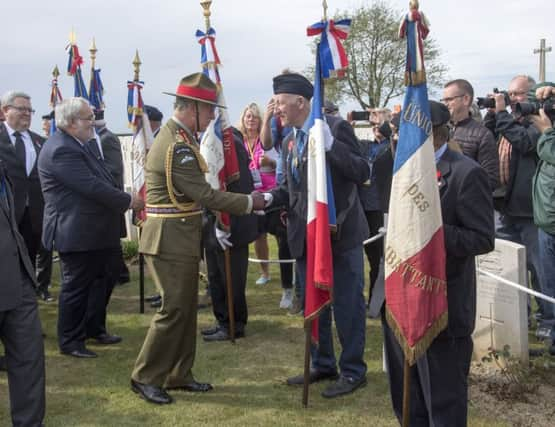Events mark 100 years since New Zealand soldiers went over the top and tanks were first used in Battle of the Somme


But, as Prince Charles reflected, 100 years ago these same fields had been an “infernal, blasted wasteland” in which soldiers fought and died in the Battle of the Somme.
Unthinkably, there were more than one million casualties during the battle which raged from July to November 1916 in the First World War.
Advertisement
Hide AdAdvertisement
Hide AdThe Prince of Wales spoke of his hope for a “future free from intolerance and conflict” as he paid tribute to New Zealand’s troops killed and injured in the battle.
He was speaking during a ceremony in France marking the 100th anniversary of the country’s involvement in the conflict.
“Standing in this peaceful scene today it is hard to imagine that a century ago this was an infernal, blasted wasteland, which my predecessor as Prince of Wales, my great-uncle Edward, described as ‘the nearest approach to hell imaginable’,” Prince Charles added.
In London a replica First World War tank took up position in central London to mark 100 years since the weapon’s first use in battle.
Advertisement
Hide AdAdvertisement
Hide AdTrafalgar Square hosted the Mark IV machine today - exactly a century since tanks were first sent into action by the British Army during the Somme Offensive in 1916.
Used at the Battle of Flers-Courcelette, the conflict at the Somme saw almost 60,000 British casualties on the first day alone,
Speaking at a commemorative service at Caterpillar Valley Commonwealth War Graves Commission cemetery in Longueval, Charles told how he had gathered with others to remember with “pride and humility” the sacrifices of New Zealand’s soldiers who fought with “boundless courage and tenacity” during the bloody battle.
Dressed for the first time publicly in New Zealand Army Field Marshal uniform, he joined figures in laying a wreath.
Advertisement
Hide AdAdvertisement
Hide AdAnd in his address, Charles added: “My hope is today we can re-dedicate ourselves to a future free from intolerance and conflict.
“We do this in honour of the memory of those who fought and died here so long ago.”
Charles spoke of the sacrifice of Pakeha and Maori soldiers in the battle, and told how New Zealand suffered a casualty rate of nearly 60 per cent.
Senior British royals and politicians, including then prime minister David Cameron, the Duke and Duchess of Cambridge and Prince Harry, led 10,000 guests gathered at the Thiepval Memorial to the Missing of the Somme in July. Today marked 100 years since the New Zealand infantry “went over the top.”
Advertisement
Hide AdAdvertisement
Hide AdBack in London Defence Secretary Sir Michael Fallon talked about the significance of the use of tank in World War One and modern warfare.
He said: “We remember the bravery of those very first tank crews and celebrate the world-leading innovation of our Armed Forces,” he added. “Those values remain hallmarks of UK defence today.”
During the First World War, in a bid to raise funds for the new tanks, the government sent the machines “on tour” around the country.
Often attracting huge crowds, Trafalgar Square hosted several of these “tank banks” where the wonder weapons were put on display.
Advertisement
Hide AdAdvertisement
Hide AdDesigned by Sir Ernest Swinton, they revolutionised British battle strategy and went from concept to combat in under two years.
A total of 1,220 Mark Series tanks were built, accommodating an eight-person crew and travelling at a top speed of four miles per hour.